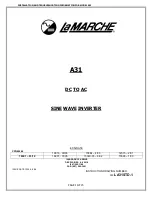
Index
025-9567E
131
from the computer to prevent inadvertent data sent via the computer from causing an error.
When the switch is in the “B” position, then the
DTR
(data-terminal-ready) signal of the
encoder, which supplies a continuous
space
level, is connected to the
RMT-CTL
signal, thus
the encoder is in the remote control mode (or computer/CAD mode). The dotted connection
in the diagram shows an extra pole added to the switch. This pole is optional and can be used
to indicate to the computer the mode in which the encoder is currently operating so that the
computer would only attempt control when the operator has the switch in the remote control
position. Normally the computer
CTS
(clear-to-send) signal would be used to monitor the
state. In the “A” position, the computer would see a
mark
level on
CTS
(not clear-to-send/
instant call mode). In the “B” position, the computer would see a
space
level on
CTS
(clear-
to-send/ remote control mode). Usually the RS-232 connector of a computer supplies a
source of
mark
and
space
levels needed for the extra optional pole.
With the operator priority option, the switch would normally be in the “remote control”
(CAD) position so that the computer can control the encoder. Then when the operator needs
control, the switch can be put in the “instant call” (operator) position so that the operator can
use the instant call keys. With this option, the CAD computer is the normal dispatcher and
the human operator serves as the backup dispatcher in case of emergency or computer crash.
The encoder operating mode should only be switched when it is idle. If the mode is switched
during a calling sequence then there is a good possibility that the stack of calls will not be
completed. In addition, if the encoder is not idle when the mode is switched, it may take
much longer for the new operating mode to take effect since the mode will not switch until
the encoder is again idle. Remember that when the mode is switched while the encoder is
idle, the encoder will be unavailable to both the operator and computer for the two seconds it
takes to reconfigure its operation. The encoder also requires the same amount of time to
configure itself after a reset (either from the RESET button or from a
break
on the
RX-
DATA
signal). Resetting the encoder will cause any call in progress to terminate, and any
instant call keys in the queue will be cleared. Also, if for some reason the computer causes an
error to occur while in instant call mode (Err0), then the serial port will be disabled. The port
can only be re-enabled by interrupting encoder power or by accessing one of the installation
aids for serial port control.
Command Protocol
Once the remote control mode has been active for two seconds or longer, the computer may
issue commands to the encoder. While in remote control mode, the controlling device (CAD)
has available all features that are available from the encoder keypad. Normally, however, a
CAD system need only make use of the instant call key stacks. Only the command protocol
needed for the instant call stacks is described here. The ASCII command sequence for
accessing an instant call stack consists of a four character decimal number followed by a
CR
(carriage return) control character. The four-digit number sent to the encoder must
correspond to one of the 206 instant call key stacks. The numbering of the instant call keys is
not continuous since the address information includes the panel number, row, and column of
the key. The number restrictions for the instant call stacks are shown in Table 31.
Содержание Model 25
Страница 1: ...Model 25 Programmable Encoder Product Manual 025 9567E...
Страница 2: ......
Страница 16: ...Specifications 8 025 9567E...
Страница 36: ...Operation 28 025 9567E RELAY TIMING DIAGRAM...
Страница 62: ...Auxiliary Panel Installation 54 025 9567E...
Страница 72: ...Troubleshooting 64 025 9567E...









































